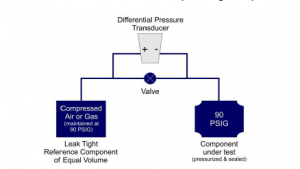For Low-Differential, Critical Pressure Applications Part 1 of 2
System manufacturers are providing the highest quality, most reliable, and most energy efficient automobiles, airplanes, turbine and gas engines, and associated components ever produced. This is due in large part to the manufacturer's ever increasing demand for rigorous test and measurement of these products. Differential pressure transducers are an integral part of that process for applications that demand reliability, repeatability, and high accuracy. This paper discusses how differential pressure transducers are used in critical pressure applications, two performance characteristics of a differential pressure transducer, and why they are important to consider when selecting a pressure transducer for low differential, critical pressure applications.
Low-Differential Pressure Transducer Applications
Differential pressure transducer are commonly used in test stands, wind tunnels, leak detection, and other applications. A test stand might use a low-pressure transducer to measure gas flow into a diesel engine to determine performance, or it could measure the efficiency of an off-road vehicle engine. Low-speed wind tunnel applications require measurements of changing air velocities. Therefore, a transducer may be calculating an aircraft's air speed, or it may measure how air flows over an automobile, or it might help determine the optimal curvature and pitch of a wind turbine blade. Leak detection systems rely heavily on differential pressure decay measurements. Overpressure protection is extremely critical because of the possibility of an accidental overload occurring when high pressures are applied.
Accuracy
Capacitance transducer suppliers reduce noise influence and utilize digital linearization processes, and their output readings today are extremely accurate. These sensors use a frequency signal output from the sensor instead of an analog signal, which at the 20-40 MHz range reduce the conducted noise entering the circuit. These high frequency signals are easily and precisely measured and "digital ready" for conditioning through digital signal processing. The accuracy of a pressure transducer is usually calculated by the root sum square (RSS) method:  Better accuracy is achieved when each of the three values are as small as possible. Hysteresis and non-repeatability are inherent in the design of the sensing element and are difficult to compensate for during the manufacturing process. These values are often indicators of the basic quality and stability of the sensor. What is compensated for during the calibration process is non-linearity.
Better accuracy is achieved when each of the three values are as small as possible. Hysteresis and non-repeatability are inherent in the design of the sensing element and are difficult to compensate for during the manufacturing process. These values are often indicators of the basic quality and stability of the sensor. What is compensated for during the calibration process is non-linearity.
Total Error Band
A significant transducer improvement is improved total error band, a result of newer transducers being thermally characterized and thermally compensated. The total error band typically includes maximum uncertainty errors for zero and span offset, zero and span shift, hysteresis, non-linearity, and non-repeatability. Total error band is measured by the difference between the most positive and most negative deviation form the true pressure. The total error band value is used to define the worst-case performance of a transducer over its compensated temperature range. Of all environmental factors, temperature influences signal output the most. Don't overlook the importance of selecting a pressure transducer with low thermal error to achieve the best performance over your operating temperature range.
CLICK HERE to learn about Setra's differential pressure transducers.



